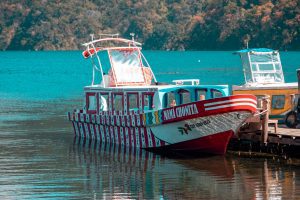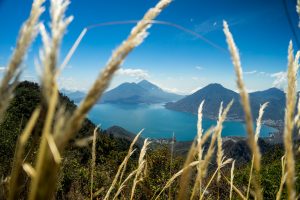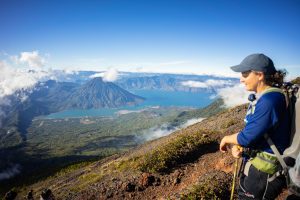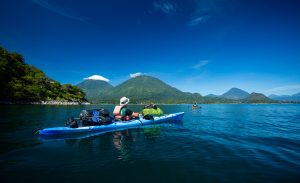Safety questions like, “Is Lake Atitlán safe?” often come up in emails from prospective travelers and concerned parents. Friends and family express worry when people announce Guatemala plans, often citing news reports about violence in Central America. The short answer: Yes, Lake Atitlán is safe. But that answer requires context, honesty about actual risks, and practical advice based on real experience rather than assumptions.
I’ve lived at Lake Atitlán since 2008, hosted over 1,000 travelers through various businesses, and led student groups, family trips, and retreat groups without a single serious safety incident in 15+ years. This track record doesn’t mean zero risk exists, but it does mean the risks are manageable, predictable, and different from what many imagine based on sensationalized coverage of Guatemala.
This guide provides honest assessment without dismissing your concerns or fearmongering. You’ll learn about actual risks, how to mitigate them, and why Lake Atitlán’s context differs dramatically from Guatemala City’s urban problems that dominate news coverage.
Table of Contents
- Is Lake Atitlán Safe? The Direct Answer
- Crime at Lake Atitlán: What Actually Happens
- Health Concerns at Lake Atitlán
- Transportation Safety at Lake Atitlán
- Lake Atitlán Safety for Different Travelers
- Practical Safety Advice for Lake Atitlán
- Real Risks vs Perceived Risks
- FAQ
Is Lake Atitlán Safe? The Direct Answer
For me, Lake Atitlán feels safer than many mid-sized American cities. Honestly, I feel safer walking around San Pedro or Panajachel at night than I do in large crowds or big events in the US. That personal perspective requires context and doesn’t mean crime never occurs, but violent crime against tourists is extremely rare.
The risks travelers actually face are petty theft (left belongings stolen), health issues (water, altitude, food), and transportation safety concerns (boats, shuttles), not violent crime, kidnapping, or assault. Understanding what actually happens versus media-driven fears helps you make informed decisions.
What safety means at Lake Atitlán: You can walk through tourist towns day and night with reasonable safety. Families with children visit regularly without incident. Solo female travelers navigate the lake successfully with standard precautions. Student groups participate in activities safely under proper supervision. The worst that typically happens is a stolen phone left unattended or mild stomach upset from street food.
What it doesn’t mean: Zero pickpocketing exists (it happens, though less than major tourist destinations). Complete laxness works (basic safety awareness remains necessary). Every situation is safe (some areas and times require more caution).
The perception gap: Media coverage focuses on gang violence in Guatemala City and border region cartel activity. Lake Atitlán, located hours away in the western highlands tourist region, exists in a completely different context. The tourist economy depends on visitor safety, and communities maintain this reputation carefully. Towns like Panajachel, San Pedro, San Marcos, and Santa Cruz welcome thousands of international visitors annually without serious incidents.
Most travelers visit without any safety problems. The remainder of this guide addresses specific concerns with practical, actionable advice.
For comprehensive Lake Atitlán planning beyond safety, see our complete travel guide.
Crime at Lake Atitlán: What Actually Happens
Petty theft represents the main crime risk at Lake Atitlán. Understanding what actually occurs versus what people fear helps maintain perspective.
What Actually Happens
Common incidents:
- Cameras or phones left unattended at restaurants disappear
- Bags left on chairs while using bathroom get stolen
- Unlocked hotel rooms occasionally burglarized
- Pickpocketing in very crowded market situations (rare but possible)
What doesn’t happen frequently:
- Armed robbery of tourists (extremely rare)
- Violent mugging for valuables (very uncommon)
- Assault for belongings (isolated incidents, not pattern)
- Kidnapping (not a concern for tourists)
- Drug cartel violence (not present in tourist areas)
Over 15 years hosting travelers, I’ve encountered perhaps 5-10 cases of petty theft—left phones stolen, unattended bags disappeared. Zero violent robberies. Zero armed incidents. Zero assaults. This doesn’t mean they never happen, but they’re rare enough that I don’t personally know locals or travelers who’ve experienced them in recent years.
How to Protect Yourself
Never leave valuables unattended—this seems obvious yet causes most theft incidents. Keep your phone in your pocket or bag, not sitting on restaurant tables. Use hotel safes for passports, extra cash, and laptops. Don’t wear expensive jewelry or flash large amounts of cash. Carry backpacks in front in very crowded situations like Friday market days in Santiago Atitlán.
Trust your instincts. If a situation feels wrong, leave. This applies universally to travel anywhere.
Town-by-Town Safety
Panajachel: Busiest tourist hub with most petty theft reports simply because more tourists create more opportunities. Still generally safe.
San Pedro: Lively nightlife scene. Occasional drunk tourist incidents. Generally safe with standard awareness.
San Marcos: Very peaceful. Minimal crime reports. Strong community atmosphere.
Santa Cruz: Quiet with few people. Very safe feeling. Limited nightlife reduces issues.
Santiago Atitlán: Authentic indigenous town sometimes intimidating for tourists unfamiliar with traditional culture, but generally safe.
Walking at Night
In tourist areas (Panajachel main streets, San Pedro lakefront, San Marcos village), walking at night is generally fine. Stick to well-lit areas. Travel in groups when possible. Avoid very late hours after 11pm. Walking between towns on dark roads invites unnecessary risk—use boats during daytime or tuk-tuks if moving between towns at night.
Women’s Safety
Solo female travelers navigate Lake Atitlán successfully. Standard precautions apply: don’t walk alone very late at night, stay aware in crowded situations, trust instincts about people. Sexual harassment is less common than in many Latin American destinations but can occur. Dress modestly (covered shoulders, longer shorts or pants) reduces unwanted attention, especially in indigenous villages where traditional culture values modesty.
What to Do If Something Happens
Report incidents to your hotel or accommodation first—staff assist with police reports and can help with replacements or contacting authorities. Contact your country’s embassy if your passport is stolen. Police reports are necessary for insurance claims. Tourist police prove more helpful than regular police for foreigner incidents.
Crime exists at Lake Atitlán but at rates lower than most travelers expect based on Guatemala’s general reputation. Basic awareness prevents most problems.
For safe accommodation choices, see our complete accommodation guide.
Health Concerns at Lake Atitlán
Health issues affect travelers more frequently than crime, but they’re predictable and preventable with basic precautions.
Water Safety
Don’t drink tap water anywhere in Guatemala. This applies universally. Brushing teeth is generally okay, but drinking tap water causes problems. Bottled water is widely available everywhere for Q5-8 ($0.65-1.00) per 1.5-liter bottle. Tourist restaurants use purified water for drinks and ice.
Prevention: Drink only bottled or purified water. Avoid ice in very local establishments (tourist restaurants use purified ice). Wash fruit and vegetables with purified water if self-catering. Carry water purification tablets as backup for remote area travel.
Food Safety
Safe options: Tourist restaurants in main towns maintain high standards with fresh food. Busy comedores (local eateries) where you see locals eating are reliable. Cooked food served hot is safe. Fruit you peel yourself (bananas, mangos, pineapple) causes no problems.
Requires caution: Street food from vendors without steady business. Raw salads in very budget restaurants. Seafood (Lake Atitlán is freshwater, so ocean fish is trucked in and not always fresh). Anything sitting out unrefrigerated for hours.
Most travelers eat without problems. Occasional stomach upset happens from diet changes, different bacteria, or spicy food, but serious food poisoning is uncommon if you stick to busy, reputable establishments.
Altitude Adjustment
Lake Atitlán sits at 1,500 meters elevation. Most people adjust without issues, but some experience mild headaches the first day or two, fatigue or breathlessness with exertion, trouble sleeping the first night, or dehydration symptoms.
Prevention and treatment: Take it easy your first day—don’t immediately hike San Pedro Volcano upon arrival. Stay very hydrated since altitude dehydrates faster. Avoid excessive alcohol the first night. Take ibuprofen or acetaminophen for headaches. Most people adjust within 24-48 hours.
Serious altitude sickness is rare at this moderate elevation. If severe symptoms develop (confusion, inability to walk straight, severe headache unresponsive to medication), descend to lower elevation immediately.
Medical Facilities
Pharmacies in Panajachel and San Pedro are well-stocked with helpful pharmacists. Small clinics exist in major towns for basic care. Private doctors charge Q200-500 ($26-64) for consultations. For serious emergencies, the nearest hospital is in Sololá (30 minutes), with Guatemala City hospitals (3 hours) handling major medical situations.
Travel Insurance
Travel insurance is essential, especially coverage including medical evacuation. Cost runs $50-150 for typical trips. Anyone doing adventure activities like volcano hiking, paragliding, or kayaking should verify activity coverage. Medical evacuation from Lake Atitlán to Guatemala City or international facilities can cost thousands without insurance.
For medical cost expectations, see our budget guide.
External resources:
Transportation Safety at Lake Atitlán
Transportation presents real but manageable risks. Understanding boat and shuttle safety helps you make informed choices.
Boat Safety (Lanchas)
Lanchas (small boats) provide primary transportation between lakeside towns. Most boats lack sufficient life jackets for all passengers. Captains prioritize safety since livelihoods depend on reputation, but overloading occasionally occurs and accidents, while rare, do happen.
How to stay safe: Request life jackets when boarding—they won’t always offer automatically. Don’t board obviously overloaded boats; wait for the next one. Sit in the middle of boats (less bouncing than the bow). Morning crossings are calmer than windy afternoons, especially March-April. Hold belongings securely to prevent anything from going overboard. Avoid boat travel in rough weather—captains usually won’t operate in dangerous conditions, but occasionally they do.
Over 15 years, I know of 2-3 serious boat incidents at the lake (capsizing in storms, collisions). These are rare but real. Fatalities have occurred, though involving locals more often than tourists. The risk is low but exists.
Shuttle Safety
Established companies like Atitrans and hotel shuttles maintain vehicles well and employ experienced drivers. Accidents are extremely rare. Always use seat belts.
Chicken buses (colorful repurposed American school buses) are less safe. Drivers sometimes speed on mountain roads, vehicles are poorly maintained, and overloading is common. If using chicken buses, sit toward the middle or back, hold belongings tightly, and prepare for aggressive driving.
Recommendation: Pay for tourist shuttles ($20-35) rather than saving $20 on chicken buses. Safety is worth the cost difference.
For complete transportation details, see our transportation guide.
Lake Atitlán Safety for Different Travelers
Different traveler types face specific considerations worth addressing individually.
Families with Children
Lake Atitlán is safe for families. Thousands visit annually without incident. Children face the same minimal risks as adults. Guatemalan culture is family-oriented—locals welcome children warmly.
Specific considerations: Water safety (both drinking and swimming in the lake). Boat safety (children especially need life jackets). Altitude affects children similarly to adults. Food safety (children’s stomachs may be more sensitive). Supervision in crowded areas applies just like any travel destination.
Towns are small and walkable—children can’t wander far. Many activities are kid-appropriate including weaving workshops, boat rides, and easy hikes.
For detailed family planning, see our complete family travel guide.
Solo Female Travelers
Solo female travelers visit Lake Atitlán successfully and safely. The strong community atmosphere and international traveler presence make it more solo-female-friendly than many destinations.
Considerations: Dress modestly (covered shoulders, knee-length shorts minimum), especially in indigenous villages. Avoid walking alone very late at night (after 11pm). Stay aware in crowds. Trust instincts. Stay in social accommodations like hostels with common areas for built-in community.
Harassment is less common than many Latin American destinations but can occur. Unwanted attention and catcalling are possible but not overwhelming. Saying “no gracias” firmly and continuing to walk usually ends interactions.
Student Groups (Teenagers)
Lake Atitlán hosts numerous student service learning groups annually. This is my specialty through Somos Impact Travel. Properly supervised groups have excellent safety records.
Requirements for safety: Experienced local guides and operators. Clear supervision ratios (1 adult per 8-10 students). Pre-established safety protocols. Emergency communication plans. Group accommodation. Scheduled activities without unsupervised free time in town.
Communities are accustomed to student groups. Established operators understand safety systems. Activities are designed for groups with proper safety measures.
For detailed information, see our complete student group guide.
Solo Male Travelers
Standard safety precautions apply. No gender-specific concerns beyond general crime awareness. Bar and nightlife safety matters in San Pedro’s lively scene—don’t overdrink and watch belongings. Solo hiking works better with partners on remote trails. Meeting other travelers is easy in hostels and tour groups.
Older Travelers
Lake Atitlán suits older travelers well with some considerations. Towns have hills and cobblestone paths. Boat docks require climbing in and out. Altitude affects older adults similarly—take the first day easy. Medical access is limited for sophisticated care—bring medications and have evacuation insurance. The peaceful atmosphere, cultural depth, comfortable accommodation availability, and shorter distances make it appealing for older visitors.
Practical Safety Advice for Lake Atitlán
Specific, actionable advice helps more than general warnings.
Before You Go: Register with your embassy (Smart Traveler Enrollment Program for Americans). Get comprehensive travel insurance. Photocopy your passport and keep it separate from the original. Share your itinerary with family or friends. Download offline maps. Learn basic Spanish phrases.
Money Safety: Use ATMs during daylight hours in populated areas. Don’t withdraw large amounts. Carry small bills separately from main money. Use hotel safes for passports, excess cash, and laptops. Credit cards work for large purchases only (many places are cash-only).
Phone and Electronics: Don’t use your phone while walking in crowds. Keep phones in front pockets or secure bags. Never leave laptops or tablets unattended. Password-protect devices. Back up photos to the cloud regularly.
Accommodation Safety: Use hotel safes if available. Lock doors and windows even if just going to the bathroom down the hall. Keep valuables out of sight even in your room. Know emergency exits. Keep hotel cards with address and phone number for taxi or tuk-tuk returns.
Emergency Contacts: Have your embassy contact information, accommodation contact details, and travel insurance emergency number saved. General emergency numbers in Guatemala are 110 or 122.
Common Sense Rules: If something seems too good to be true, it is. If a situation feels wrong, leave. Don’t do things you wouldn’t do at home. Blend in rather than looking obviously like a wealthy tourist. Stay aware of your surroundings.
Real Risks versus Perceived Risks
Understanding what to actually worry about versus overblown fears helps you focus energy appropriately.
DO Worry About (Real Risks):
- Minor theft from leaving valuables unattended
- Stomach issues from drinking tap water or questionable food
- Boat safety in rough weather or overloaded boats
- Altitude sickness—take it easy the first day
- Transportation incidents (shuttle accidents are rare but possible)
DON’T Worry Excessively About (Overblown Fears):
- Violent crime against tourists (extremely rare)
- Kidnapping (not a concern for tourists here)
- Drug cartel violence (not present at tourist destinations)
- Corrupt police targeting tourists (not common in tourist areas)
- Getting “stuck” (transportation functions reliably)
Most safety fears about Guatemala stem from news coverage of urban gang violence or border cartel activity. Lake Atitlán, located hours away in a highland tourist region, exists in a completely different context.
What actually sends people home early: Severe stomach illness from ignoring water advice. Family emergencies at home (nothing to do with Guatemala). Not liking the atmosphere (personal preference, not safety). Running out of money (budgeting issue).
What doesn’t send people home: Safety incidents (extremely rare). Feeling physically threatened (uncommon). Serious crime (not happening to tourists regularly).
Lake Atitlán Safety FAQs
Is Lake Atitlán safe for tourists in 2025?
Yes, Lake Atitlán is safe for tourists in 2025. After 15+ years living here and hosting over 1,000 travelers, the actual safety level exceeds what most expect based on Guatemala’s general reputation. Violent crime against tourists is rare. Main risks are petty theft (unattended belongings), minor health issues (water and food), and transportation safety (boats, shuttles). Using common sense and basic precautions, travelers visit regularly without incident. The tourist economy depends on visitor safety, and communities maintain this carefully.
Is Lake Atitlán safer than Guatemala City?
Yes, Lake Atitlán is significantly safer than Guatemala City. The lake exists in a highland tourist region hours from the capital’s urban problems. Gang violence affecting Guatemala City doesn’t occur in Lake Atitlán tourist areas. While Guatemala City has dangerous zones tourists should avoid entirely, Lake Atitlán’s main towns (Panajachel, San Pedro, San Marcos, Santa Cruz) are safe for walking and normal tourist activities day and night with standard precautions.
Can you drink the water at Lake Atitlán?
No, do not drink tap water at Lake Atitlán or anywhere in Guatemala. Drink only bottled water (widely available for Q5-8 / $0.65-1.00 per bottle) or water purified through proper filtration. Brushing teeth with tap water is generally okay, but sensitive stomachs should use bottled water even for this. Tourist restaurants use purified water for drinks and ice. This is the single most important health precaution for preventing stomach illness.
Is Lake Atitlán safe for solo female travelers?
Yes, Lake Atitlán is relatively safe for solo female travelers compared to many destinations. Thousands of women travel solo here annually without serious incidents. Standard precautions apply: dress modestly (covered shoulders, knee-length shorts minimum), avoid walking alone very late at night, stay aware in crowded situations, and trust your instincts. Harassment occurs less frequently than in many Latin American destinations. Social hostels in San Pedro and the yoga community in San Marcos provide natural opportunities to meet other travelers.
Are the boats at Lake Atitlán safe?
Boats at Lake Atitlán are generally safe but require awareness. Most boats lack sufficient life jackets—request them when boarding. Don’t board obviously overloaded boats. Morning crossings are calmer than windy afternoons (especially March-April). Serious incidents are rare but do occur occasionally in rough weather. Boat captains depend on safety reputation for their livelihoods. Tens of thousands of crossings happen safely annually, but risk is real enough to warrant precautions like wearing life jackets and avoiding travel in storms.
Is it safe to walk around Lake Atitlán at night?
Yes, walking in main tourist areas (Panajachel’s center, San Pedro lakefront, San Marcos village) at night is generally safe with standard precautions. Stick to well-lit, populated areas. Travel in groups when possible. Avoid very late hours (after 11pm) and don’t walk between towns on dark roads—use boats during the day or tuk-tuks at night. Most safety issues at night involve drunk tourists (bar scene in San Pedro) rather than locals threatening visitors.
What should I do if something gets stolen at Lake Atitlán?
If something gets stolen, first report to your hotel or accommodation—staff will help file police reports and can assist with replacements or contacting authorities. For passport theft, contact your country’s embassy immediately. File a police report for insurance claims (tourist police are more helpful than regular police for foreigner incidents). Most hotels have experience handling these situations. Prevention is easiest: never leave valuables unattended, use hotel safes, keep phones in pockets not on tables.
Is Lake Atitlán safe for families with children?
Yes, Lake Atitlán is safe for families with children. Thousands of families visit annually without incident. Guatemalan culture is family-oriented and locals welcome children warmly. Main considerations are water safety (don’t drink tap water), boat safety (ensure children have life jackets), altitude adjustment (same as adults), and food safety (children may have more sensitive stomachs). Towns are small and walkable—children can’t wander far. Many activities are kid-appropriate including weaving workshops, boat rides, and easy hikes. See our complete family travel guide for detailed planning.
Do I need travel insurance for Lake Atitlán?
Yes, travel insurance is strongly recommended for Lake Atitlán, especially coverage including medical evacuation. While serious incidents are rare, medical facilities at the lake are basic—serious emergencies require transport to Guatemala City hospitals (3 hours away). Insurance covers medical care, evacuation costs, trip cancellation, and stolen belongings. Cost runs $50-150 for typical trips. Anyone doing adventure activities (volcano hiking, paragliding, kayaking) should verify activity coverage.
What are the most common safety issues at Lake Atitlán?
The most common safety issues at Lake Atitlán are minor theft (left belongings stolen), stomach illness (from tap water or questionable food), altitude sickness symptoms (headache, fatigue at 1,500m elevation), and boat safety concerns (rough crossings, insufficient life jackets). Violent crime against tourists is rare. Most safety incidents result from not taking basic precautions like securing valuables, drinking only bottled water, requesting life jackets on boats, and taking altitude adjustment seriously the first day.
Final Thoughts on Lake Atitlán Safety
Lake Atitlán is safe for travelers using common sense and basic precautions. After 15+ years living here and hosting 1,000+ travelers, I’m confident recommending the lake to families, solo travelers, students, and groups. The actual risks—petty theft, minor health issues, transportation safety—are manageable and predictable.
The tourist economy depends on visitor safety and positive experiences. Communities protect their reputation carefully. Established infrastructure serves travelers through reliable shuttles, quality hotels, and experienced guides. Geographic separation from Guatemala’s urban problems means Lake Atitlán exists in a different context entirely.
Your responsibility: don’t leave valuables unattended, drink only bottled water, use established shuttles and tour operators, request life jackets on boats, stay aware in crowded situations, and trust your instincts about people and places.
The vast majority of travelers visit Lake Atitlán without any safety incidents. The lake delivers authentic cultural experiences, stunning natural beauty, and warm community hospitality.
Get our free Lake Atitlán safety checklist and emergency contact card. Sign up here
Ready to plan your safe trip? See our complete travel guide for comprehensive information.Planning a student group or family trip? Contact us for safety protocols and experienced guide recommendations.
Related Articles
-

How to Get to Lake Atitlán: Complete Transportation Guide from Guatemala City & Antigua
-

Where to Stay in Lake Atitlán: Complete Town-by-Town Accommodation Guide
-

Complete Lake Atitlán Travel Guide 2025: Best Towns, Things to Do & Planning Tips
-

Lake Atitlán Family Travel Guide: Safe, Kid-Friendly Activities & Where to Stay
-

Lake Atitlán for Student Groups: Complete Educational Travel & Service Learning Guide




